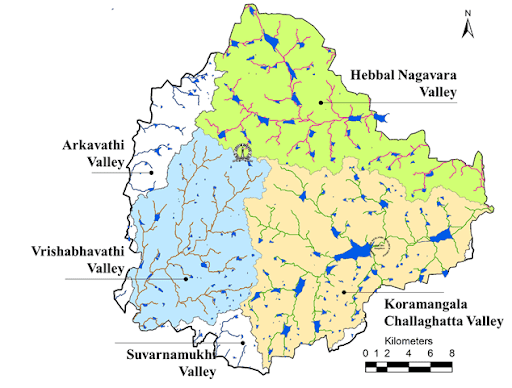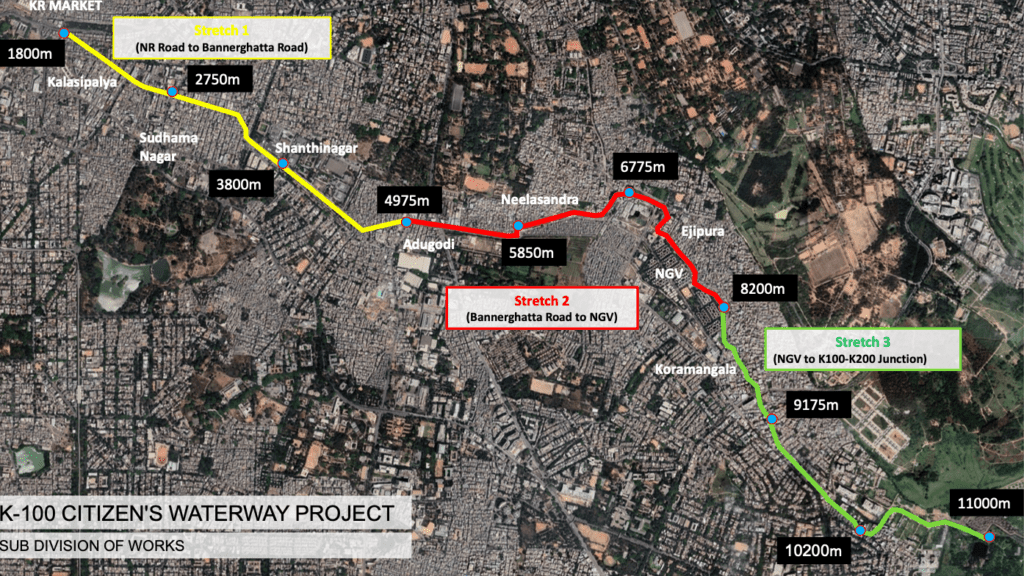[BBMP, in coordination with other government agencies, has initiated the K100 (Citizens’ Water Way) project to rejuvenate the stormwater drain network between Majestic and Bellandur lake. Mod Foundation, an urban action and research institute, has been working with these agencies to ensure the project’s goals are met, and is also facilitating the overall design concept. The author, who is part of the Mod Foundation, gives details of the project in this article.]
There is growing awareness about the dire state of Bengaluru’s lakes, which has mobilised citizens, institutions and the government to take action. Storm water drains (SWDs) are a crucial part of the city’s lake ecosystem, and hence the entire network has to be addressed in an attempt to solve the city’s water crisis.
A lack of general awareness and civic sense, both on the part of the community and the authorities, has resulted in the current state of SWDs in the city. BBMP’s proposal to rejuvenate SWDs is aimed at addressing the distressing state of ecology in the city, rehabilitating the traditional water management system, and reviving the community-environment relationship. The K100 project aims to create among citizens a sense of responsibility and ownership of the city’s traditional water network and management system.
Bengaluru’s current SWD network is expansive, covering about 850 km across the city, offering great potential to transform the edges of the water channels and to create multiple public spaces along the channels. This will enhance the social value of the rajakaluves through community engagement. The proposal looks at restoring the rajakaluve network as an ecological corridor that functions as a natural filter.
Read more : Redesigning a road: Lessons from Church Street
What is the project about?
Of Bengaluru’s SWD network of approximately 850 km, 400 km are rajakaluves or primary stormwater drains. One of the most historically significant rajakaluves is the K100, which starts from Shanthala Silks near the erstwhile Dharmabuddhi lake (now Majestic/Kempegowda bus stand), and drains into Bellandur Lake.
This rajakaluve’s catchment area spans 32 sq km, which includes the historic city, cantonment and newly-formed layouts post-independence. This waterway can be seen in maps of the area dating back to 1885. As the city grew outward with increasing population and industry, the rajakaluve started to get more and more channelised.
K100 rajakaluve has been taken up as a pilot in the larger project to rejuvenate the city’s SWD system.
To understand Bengaluru’s water management system, it is important to understand the city’s topography. Bengaluru has three major natural valley/drainage zones, and three minor ones. The major valleys are Vrishabhavathi Valley, Koramangala-Challaghatta Valley and Hebbal Valley. The minor valleys are Tavarekere, Kathriguppe and Arkavathi.
Given the nature of this topography, it was natural to lay sewers from ridges to valleys along the natural terrain, to achieve gravity flow and avoid pumping costs. Hence trunk sewers were built along the valleys, often alongside or inside the storm water drains for natural drainage. The K100 network is no exception to this manner of planning.
Since the trunk sewers are built within the storm water drains in several locations, greater care is required during design and construction to prevent infiltration/ inflow of stormwater into the sewers and vice versa. The K100 network follows gravity flow, except in a few places where sewage pumping stations had been installed to pump the wastewater to sewage treatment plants (STPs).

Key design interventions
The interventions have been planned such that the carrying capacity of the drain channel is not hampered.
These include:
- Elimination of sewage inflow, untreated industrial effluents or garbage dumping in the rajakaluve
- Removal of contaminated silt from the drain beds
- Using natural materials and natural bio-remediation techniques to improve water quality as well as increase natural infiltration
- Creating pedestrian-friendly infrastructure where possible
- Redesigning existing culverts and bridges to increase drain capacity
Key objectives
- Reframe the storm water drains from mere ‘grey infrastructure’ to creating an ecological corridor with active involvement of citizens
- Reconnect the city to its water heritage
- Use natural processes to act as a remedial tool
- Increase the availability of public spaces in the city for recreation and health
- Address key issues of pollution, air quality, water scarcity and flood mitigation
- Inculcate a sense of pride and ownership among citizens
Read more: Why BBMP’s stormwater drain encroachment clearance drive is delayed
Roles of multiple stakeholders
Multiple government agencies are involved directly to ensure that the K100 stormwater drain is restored to the required standards. Interdepartmental coordination is key for such a complex project.
Following are the major stakeholders.
SWD Department, BBMP
BBMP’s SWD Department is solely responsible for the project, as the implementing agency as well as the entity vested with the responsibility of all the SWDs in the city.
The execution strategy for the project involves dividing the drain into three stretches, each roughly 1 km long:
- Stretch 1 : NR Road to Bannerghatta Road
- Stretch 2 : Bannerghatta Road to National Games Village (NGV)
- Stretch 3 : NGV to Bellandur lake junction

To address the illegal inlets not visible in the closed drain, a STP of 5 MLD is being planned in Kumbargundi. This STP will also ensure regular water flow in the waterway in dry periods. Efforts are also being made to channelise treated water from other sources.
BBMP faces the challenge of clearing encroachments on the drain, as per the National Green Tribunal order. The Palike has already cleared encroachments at the first bridge near NR Road (image below). Other buildings on JC Road and Lalbagh Road are awaiting court orders for clearance.
Desilting of drains is another major challenge. The SWD Department has ramped up efforts to desilt the secondary drain network across the entire 32 sq km catchment area. This is a difficult task since this network has 10 secondary SWDs, which includes 11.5 km of open drains and 9.6 km of closed drains.
Waste enters the drain from multiple sources:
- Sewage from illegal inlets and secondary SWDs
- Treated water/seepage pumped by large buildings
- Sewage and sullage from slums
- Untreated sullage from establishments like slaughterhouses
- Effluents from dyeing units and service stations
- Solid waste from nearby markets
- Dumping of solid waste

At present, the mock-up area of roughly 300 m length is under construction opposite the Shanthinagar bus station on KH road.
Solid Waste Management (SWM) Department, BBMP
BBMP SWM Department is in charge of containing unregulated waste dumping into the drains, identifying black spots in the catchment, educating residents not to dispose of their waste indiscriminately as well as increasing the frequency of dispatching mobile compactors for pickups. The department has prepared extensive micro-plans to monitor status and to increase awareness among citizens.
BWSSB
BWSSB is a crucial stakeholder directly involved in ensuring the health of the K100 drain. The nature of the project requires efficiency and co-ordination between BBMP and BWSSB to ensure minimal sewage and perennial water supply.
BWSSB has to ensure that new STPs along the K100 drain are built in accordance with the water quality requirements, using the latest technologies and with minimal invasiveness. They also have to ensure the maintenance of the sewer lines found along the drain, to prevent the contamination of stormwater with sewage.
During the course of this project, BWSSB has identified pipelines requiring rehabilitation and replacement. In addition to correcting undulations in the trunk sewer lines built under the bed of K100, BWSSB has engaged consultants to identify points for an immediate rectification plan. The agency is also conducting a door-to-door survey to identify houses without sewerage connections, so as to connect them to the network. (In certain densely populated areas, sewers were found to be directly connected to the K100 drain.) BWSSB is making efforts to build a new sewer network as well as repair any damages caused to their overall network.
Read more: What the journey of sewage tells us about lives and livelihoods in Bengaluru
BWSSB has diverted the nearly 110 MLD (Million litres per day) of sewage in its trunk line to an Intermediate Pumping Station (ISPS) at NGV, by laying a trunk sewer from Chickpet metro station to NGV. All submains and lateral sewers were subsequently connected to this network, using pipes with diameter ranging from nearly 900mm to 2400mm.
Clearing silt from the sewer line is a major challenge, and BWSSB is exploring a pilot using robotic technology to tackle this. Water jet from a jetting machine will be used to spin the turbine at a very high speed and remove blockages and sediments.
Karnataka State Natural Disaster Monitoring Centre (KSNDMC)
KSNDMC’s primary objective is to validate the planning of the K100 drain through risk assessments. The Centre has installed multiple sensors at various intervals along the drain to establish high floodline levels, flooding and choke points, and low-lying beds. They have also aided in the understanding of rainwater management schemes and groundwater recharge in the concerned watershed area.KSNDMC’s primary objective is to validate the planning of the K100 drain through risk assessments. The Centre has installed multiple sensors at various intervals along the drain to establish high floodline levels, flooding and choke points, and low-lying beds. They have also aided in the understanding of rainwater management schemes and groundwater recharge in the concerned watershed area.
Karnataka State Pollution Control Board (KSPCB)
KSPCB’s focus is to plan a comprehensive programme to prevent and abate the pollution of the rajakaluve, and to implement this by identifying and terminating unauthorised connections.
Bengaluru Electrical Supply Company Ltd. (BESCOM)
BESCOM has rerouted their utilities that previously crossed the drain, and is upgrading their infrastructure along the K100 network with Compact Substations (CSS). This technology is safer, and eliminates exposed wires above the ground.
Star Infratech
The city-based construction firm Star Infratech is in charge of executing the project.
[Corrigendum: This article previously mentioned that waste from KR Market enters K100 drain. This has been modified to say that waste from nearby markets enters the drain.]
So many hurdles. Because of not focused on future population, developments, extension of Bangalore beyond the imagination, present citizen are facing water logging, flooding, sewage flows, connected sewage lines to SWD which is ilegal and so on.
Really it is a challenge to all connected govt organizations to rectify this.
This is hog wash by BBMP to make more money. If you don’t believe me come and see for yourself the Hebbal valley. BBMP and BWSSB do not difference between storm water drain and sewage drain. Don’t have any hope they will improve. Added to this the Garbage Mafia that dumps Garbage in to SWDs. So much for swacchata andolana.
[Ed: This comment has been edited as per our Comments Policy]
One of the earlier mayor Mr.Ramesh from parvathipuram Bangalore when intervied by a news channel had mentioned that he likes to travel on a boat in rajakaluve, I think it is going to be true. May the divine powers bless u with infinite amount of energy to clear obstacles from evil and establish a nice rajakaluve
The plan should be supported by Citizens. The concept to do outbeats the age old irresponsible attitude of rulers and administrators. Let us accept the change.
The need of the hour is rejuvenating and preserving the cascading lake system which will have better impact than taking up in isolation this show piece.This will divert the attention. There should have been public consultation before launching of this project
All 3 Valleys need attention. However, it is important to revive the Vrishabhavathi Valley and River. A few decades ago, people used to bathe in this river before entering Gali Anjenaya Temple on Mysore Road. Our specific request is to immediately start planning to tackle this on a war-footing, base don the experiences with K100, so that we can see Bengaluru’s only river flow like its old self, soon. Thanks to all those who are working on this Project.